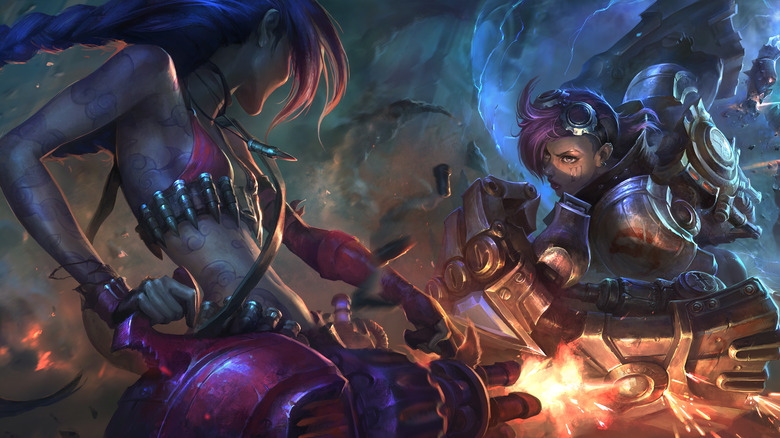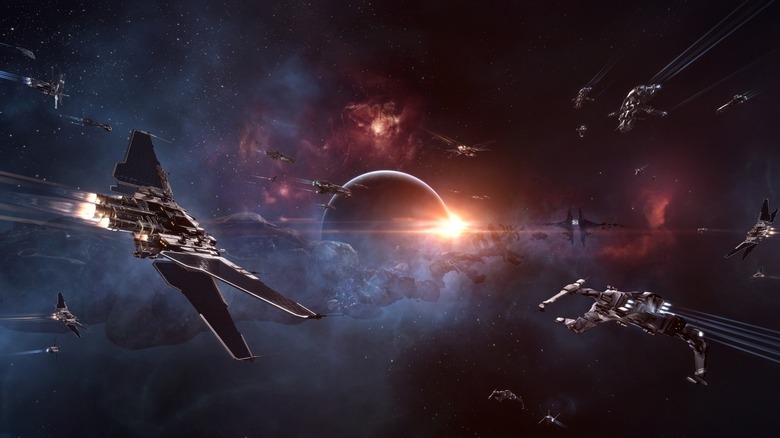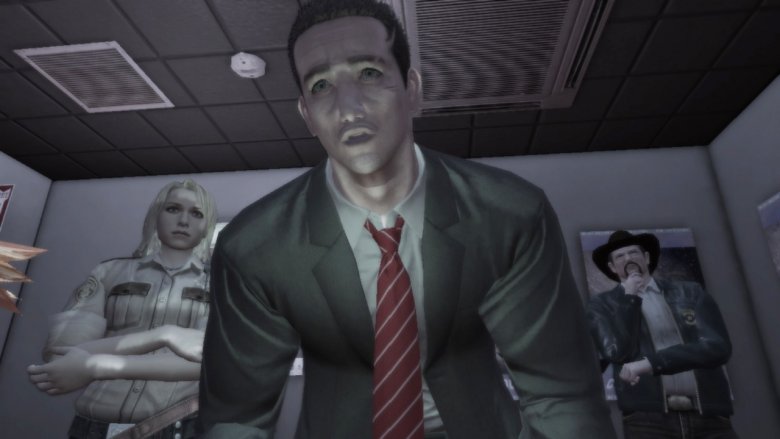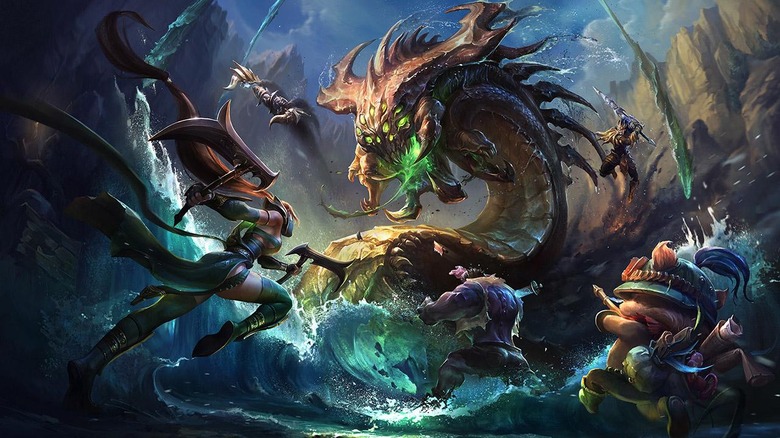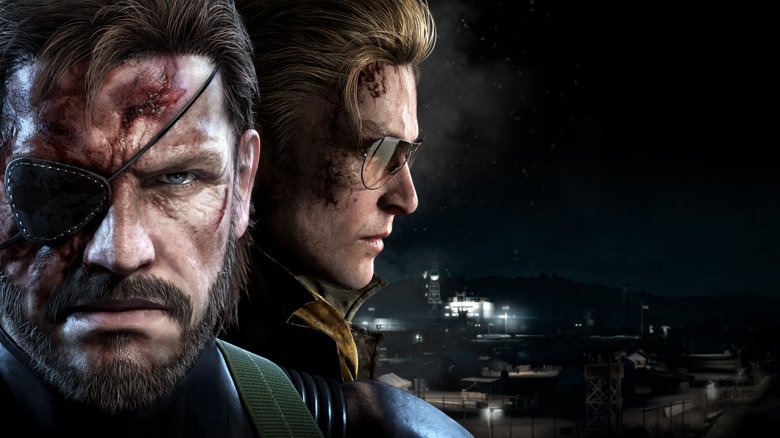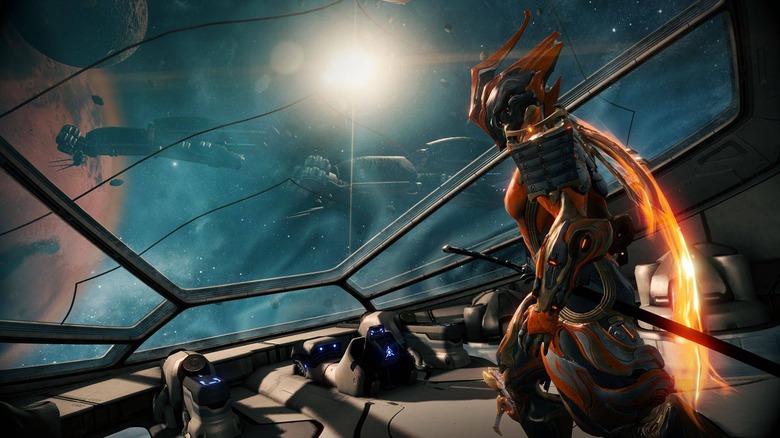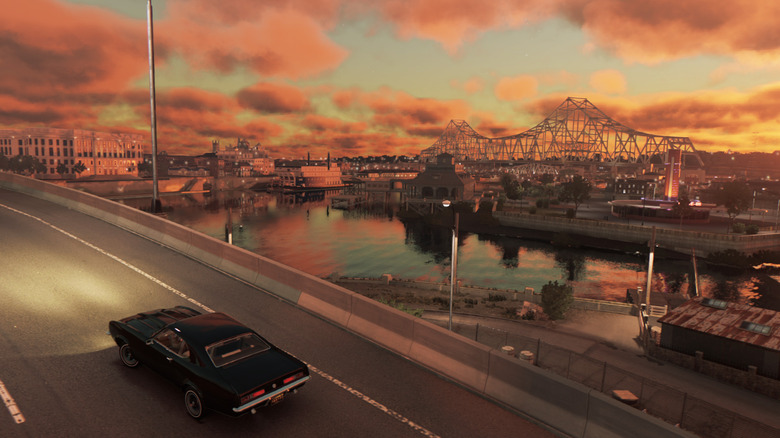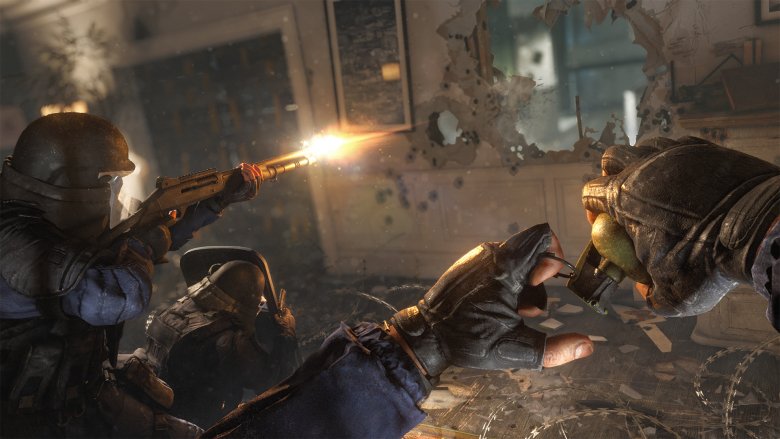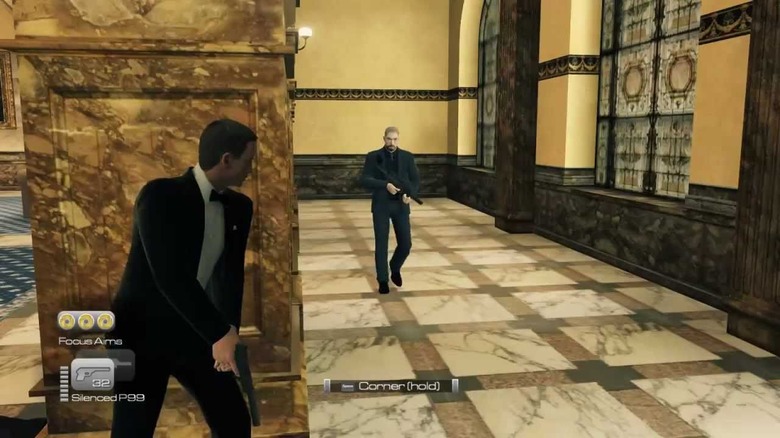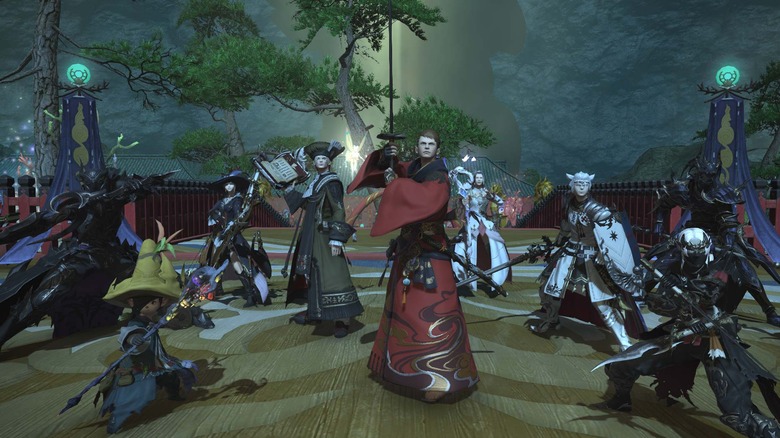Games With Disappointing Metacritic Scores That Are Actually Awesome
Professional reviewers play a whole lot of games: good ones, bad ones, generic ones, boring ones. Every once in a while, they're even lucky enough to play a great one. In all that criticism, though, sometimes a game falls through the cracks: a jewel is doomed to mediocre scores, forever saddled with a yellow or even — gasp! — red number on MetaCritic.
Maybe the game was too far ahead of its time, or just too plain weird for the reviewers to understand what they were looking at. And increasingly, in this era of games as a service, a game at release looks nothing like it might a year later. But even as the game grows and evolves, that MetaCritic score stays ever the same. Here are some games that are much better than their scores would have you believe. Some of them are pretty good; some of them are pretty great; and one of them is the biggest game in the world. Not that you'd ever know by checking MetaCritic.
EVE Online - MetaCritic: 69
EVE Online is a strange MMO, in that its core functionality isn't what it appears to be. On the surface, it's a starship-based game in which you fly across the universe, battle pirates and other players, and upgrade your vehicle. Standard MMO fare, except in space. And when it first released in 2003, it didn't seem to do even that very well. Between the simplistic combat and the glacial upgrade pace, most reviewers saw EVE Online as a title with gorgeous visuals, but little else.
What those reviewers appear to have missed was that, secretly, EVE Online isn't about space: it's about spreadsheets. The true heart of the game is in its sophisticated, player-driven economy, which is affected and influenced by player-controlled corporations set up within the game. Handling, modifying, and speculating on prices for various items and gear make up the bulk of time spent playing EVE. The spaceships are fun, and players still enjoy exploring and battling around the galaxy. But cutthroat capitalism is the true wargame inside EVE Online.
Maybe there was no way for reviewers to see that on launch day. Indeed, very few other games have attempted anything like it since. But as it stands, EVE Online remains one of the top MMOs on the market, over a decade after it was released to its mediocre reviews.
Deadly Premonition - MetaCritic: 68
Deadly Premonition is a spectacularly, gloriously, even disturbingly bizarre game. The lead character, a detective, frequently talks to his imaginary friend Zach. Its voice acting runs the gamut from "bad" to "very bad." And the cast of characters are every color of weird in the weird rainbow, from a lady with a talking cooking pot to an entrepreneur who always wears a gas mask. And to top it off, its graphics were dated when it released in 2010, and its controls were as crisp and responsive as a block of concrete. Most reviewers, naturally, were unkind. IGN said it was a system seller, in the sense that it made you want to sell your system.
But then a funny thing happened: the game became a cult phenomenon. Sure, there was no saving the crummy graphics or numb controls, but the unapologetic strangeness of the game came to be seen as a feature, not a bug. Like a piece of absurdist theater, Deadly Premonition's very wackiness became the reason to play the game. What tied it all together was the fact that the game never, at any point, compromised its vision: it wanted to be the most gonzo headtrip adventure it could be, and by golly, it was!
In the end, Deadly Premonition earned enough of a following to warrant a Director's Cut release, which fixed some of the bugs and tightened up the overall experience. Which was still weird. It retains a devoted fan base to this day.
League of Legends - MetaCritic: 78
You've probably never heard of League of Legends, provided you've lived under a rock for the last ten years. Otherwise, the world's biggest game is the monster you can't escape from, even if you don't play it yourself. Somebody you know plays it, and is probably obsessed with it. Meanwhile, games of every stripe are still trying to unwind its magic formula for microtransactions. And all the while, it's free, so anybody can try it out for no money down. As a game, its balance of distinct heroes, numerous items and item-combinations, upgrade progression, and technical skill have elevated the game to one of the world's biggest eSports. It is frequently either at or near the top of most-viewed games on Twitch.
None of this was apparent to reviewers when the game first released in 2009. Indeed, Game Informer stated that "it's too bad that Riot Games didn't take more chances with League of Legends, because the basic premise is good enough to have made Defense of the Ancients a subgenre unto itself." GI is referencing a popular mod of Warcraft III called Defense of the Ancients, or DOTA for short. League of Legends was an early attempt to grow that mod into a commercial product, and it is fair to say that the League apple didn't fall too far from the DOTA tree. But the genius of the game was in its flawless, not innovative, execution. Perhaps the reviewers just weren't skilled enough players to see the greatness in its design. Their teammates probably let them know about it. Loudly.
Metal Gear Solid V: Ground Zeroes - MetaCritic: 75
Hideo Kojima is one of the true auteurs of the gaming medium: his signature Metal Gear Solid franchise is tense, action-packed, thoughtful, innovative, and goofy, all at once. For the fifth game in the franchise, he decided to develop an open-world game for the first time. His ambitions were enormous: he didn't just want large play spaces, but a deeply interconnected series of systems that had substantive effects for the player that were still relatively simple to grasp and gave the player lots of options to customize their playstyles. Plus, he wanted to build his own engine from scratch. Plus-plus, he wanted to hire marquee actors, like Kiefer Sutherland. In other words, Metal Gear Solid V was an expensive undertaking, and it was taking forever to make.
So in 2014, publisher Konami decided they needed to start seeing a return on their investment sooner rather than later. They told Kojima to hand over something, anything, that they could sell. The result was Metal Gear Solid V: Ground Zeroes, a two-hour experience set in a large, though not huge, open world space that contained enough replayable elements to justify a purchase. Barely. Even at a discounted price of $40, reviewers largely scorned the release as a clear cash-grab on Konami's part, a paper-thin exercise that didn't live up to the franchise's lofty heights.
Here's the thing, though: Ground Zeroes is really just the first chapter in the sprawling Metal Gear Solid V experience. It introduces the brilliant open-world design, the updated take on the action-stealth mechanics that the series pioneered in the first place, and the characters and plotlines that would later drive the full release, Metal Gear Solid V: The Phantom Pain. In all, what Ground Zeroes had was superlative–there just wasn't very much of it. But taken as a complete work, Metal Gear Solid V is one of the seminal game releases of the last decade.
Warframe - MetaCritic: 64
Warframe was released in 2013 to little fanfare, appearing to be just another power-armor-in-space shooter. The developer, Digital Extremes, had never produced a major hit on its own (though it had done outsource work for the Unreal and BioShock series before). The fact that it was free-to-play didn't seem like a sign of quality, either. Reviewers declared it a mediocre output, a faceless product in a sea of better competition. Eurogamer said "the only reason this game is free to play is that nobody would pay money for something so scrappy and generic."
Funny thing about that scrappy, generic game, though: years after its release, it's one of the most-played games on Steam. Digital Extremes has continued to develop, improve, and add content into the game, turning the flimsy launch product into one of the deepest and most rewarding titles on the market. Its huge number of interlocking systems can be a bit overwhelming to first-time players, but eventually prove to be just as sophisticated. And the dizzying array of customization options truly lets gamers find a playstyle they prefer, and then fine-tune it down to the molecules.
Polygon, tongue a bit in cheek, now calls Warframe a "perfect game." Not bad for a game they originally scored at 50.
Mafia III - MetaCritic: 68
Mafia III isn't without its problems: its graphics are dated, its controls are clunky, and its combat design is straight out of the previous decade. So the poor reviews from 2016 weren't necessarily 'wrong,' in the sense that reviewers had to give consideration to these genuine flaws in the game. But even the critics gave credit to one aspect of the game, that over time has risen to be its defining feature: the story.
From its 1960s Louisiana setting, to its head-on confrontation with racial issues in the American South, to the raw portrayal of its main character, Mafia III dealt with themes and subject matter that most major releases wouldn't dare touch. The cinematics and performances were first-rate, dripping with vengeance, regret, and operatic melodrama. And none of that mentions the fact that Mafia III is one of only a few games featuring a black protagonist, played with depth and broken humanity by Alex Hernandez. Remember, this is a game set in the American South in the 1960s. And Mafia III pulled no punches there, either.
Strictly as a game, its flaws will prevent it from ever being considered a true classic. But as a story, and as a direct challenge to the risk-averse narratives of most other games, Mafia III is one of the most interesting, thought-provoking, and memorable titles of the last five years.
SimCity (2013) - MetaCritic: 64
SimCity had a small problem on release: namely, it didn't work. A game that most people would only enjoy as a single-player experience had to connect to Electronic Arts' servers, for some reason. Yet for the whole first week, it had trouble doing just that. And so the game wouldn't let anyone who paid for it actually play it.
Electronic Arts finally got the whole system moving (though they had to disable a bunch of features to do it). Even then, SimCity featured a variety of bugs and poor design decisions, such as a playspace that was too constricted for most cities to build into, which is the point of the entire game. Critics were swift to slam EA, ever the punching bag of the gaming industry. SimCity 2013 became the most reviled releases in the franchise's storied history.
But over time, EA patched up the various bugs, and eventually disabled the online requirement altogether. Though a few design decisions, such as the small playspace, hold the game back from joining the series' greats, the vast bulk of the issues that reviewers had with the game are now gone. As it stands, the 2013 SimCity is a perfectly acceptable entry in the franchise, one which will forever be saddled with a poor MetaCritic score that is, frankly, for another game that no longer exists.
Tom Clancy's Rainbow Six: Siege - MetaCritic: 73
Tom Clancy's Rainbow Six: Siege was a pretty slim package when it launched in 2015, featuring only a handful of modes and maps, and no single-player at all. Particularly when compared to previous Rainbow Six entries, Siege just seemed like a slapdash affair without much meat on its bones. Reviewers felt like a lot of the franchise's soul had gotten lost.
Even so, most reviewers did point to one standout feature: the competitive multiplayer. Tense, taught, and tactical, Rainbow Six: Siege broke out of a crowded landscape of run-and-gun, spray-and-pray shooters. Players in Rainbow Six: Siege had no regenerating health to help them recover from mistakes. Rather, they had to rely on strategic thinking, good communication, and precision aim to carry the day.
Despite the poor reviews and uninspiring early sales, Ubisoft believed in the title enough to continue adding new maps and characters. Slowly, word of mouth on the title grew, attracting gamers in search of a true test of skill. And there sure were a lot stepping up to the challenge: years after its release, Rainbow Six: Siege has become a bona fide megahit with over twenty million units sold. Siege now boasts a burgeoning eSports scene as well, which has only drawn further attention and praise. The reviewers were right: Siege wasn't like the Rainbow Six games of old. But it was still great.
James Bond 007: Blood Stone - MetaCritic: 62
Licensed video games have a pretty poor reputation among gaming circles: they tend to be cheaply made, badly designed clunkers that just try to crank out a few sales based on brand recognition. Movie tie-ins are the worst offenders in this regard. Because of that, 2010's James Bond 007: Blood Stone was always going to face an uphill struggle, particularly with wary professional reviewers, who have played a lot of bad licensed games. And indeed, Blood Stone wasn't without issues: its mechanics were derivative, its missions were repetitive, and the driving was just flat awful–and this from Bizarre Creations, makers of the Project Gotham Racing games!
But Blood Stone was more than just a cheap copy of a much better movie: it featured its own story written by Bruce Feirstein of GoldenEye fame, with marquee names like Daniel Craig and Joss Stone voicing characters (Stone also provided an intro song in classic Bond style). Even critics who were harsh on the gameplay admitted that Blood Stone nailed the tone and feel of a Bond film just right. And one of the major critical complaints–the game's six-hour campaign–doesn't look so bad when compared to the two-hour runtime of a 007 film.
In other words, Blood Stone was actually a great Bond experience: it was just being judged by a game-focused press. Other titles might have better combat or driving, but for people who like globetrotting, mystery-solving, and martini-drinking, Blood Stone was a more than worthy addition to the 007 lineup. It just happened to be interactive, instead of a film, and so was judged by a different press.
Final Fantasy XIV Online - MetaCritic: 49
Final Fantasy is a juggernaut of the gaming world, one of the longest-running and most-beloved franchises around. In 2003, developer Square Enix brought the RPG series in the online realm with Final Fantasy XI, their first MMO. The success of that game lead them to develop a newer online product, which finally released in 2010 as Final Fantasy XIV Online. And it was terrible.
A complete mess from start to finish, Final Fantasy XIV was easily the biggest stumble in the venerable series' history. Critics broadly agreed the game just felt unfinished, with a paucity of quests to partake in and an awful user interface. Add in the poor server connections, and the end result was just a misfire on every level. Final Fantasy XIV reviewed horribly, garnering a dismal 49 on MetaCritic. The game was dead on arrival.
But play it today, and it's great, one of the best MMOs around. How? Because Square Enix realized the threat to the Final Fantasy brand, and chose to throw in the resources necessary to save it. The result was Final Fantasy XIV Online: A Realm Reborn in 2013, a fully reworked and revamped version of the game. And it fixed pretty much everything. From the huge number of quests, to the improved server connections, to the usable user interface, A Realm Reborn was everything Final Fantasy XIV should have been in the first place. In fact, it felt like a best-hits collection of everything that made MMOs awesome, a kind of modern-day throwback to great MMOs of old. Today, it is one of the most-played MMOs in the world. Not bad for a game that almost no one liked.

